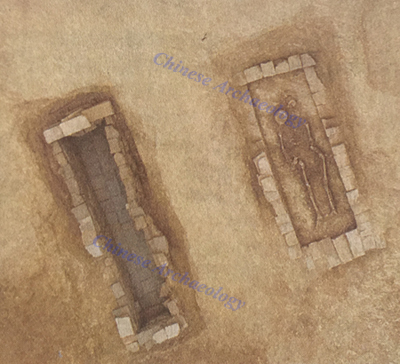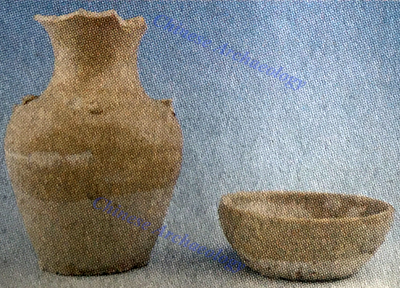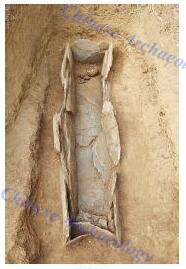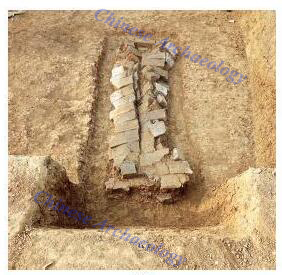Information
Cemetery of Han-Wei and Six Dynasties Found in Yangjiahe, Hubei Province
Summary: Cemetery of Han-Wei and Six Dynasties Found in Yangjiahe, Hubei ProvinceFrom:Chinese ArchaeologyWriter:Date:2017-08-15From June to September 2016, Xianning Museum and other institutes conducted an archaeological excavation to Yangjiahe Cemetery, excavated
Cemetery of Han-Wei and Six Dynasties Found in Yangjiahe, Hubei Province
From:Chinese Archaeology Writer: Date:2017-08-15
From June to September 2016, Xianning Museum and other institutes conducted an archaeological excavation to Yangjiahe Cemetery, excavated 10 tombs (9 brick-chambered tombs, 1 stone slab tomb) of the Han¬¬¬-Wei and Six Dynasties, unearthing celadon porcelain, pottery, copperware, ironware and jade objects, altogether 37 pieces (sets). Yangjiahe Cemetery is located at Zengdu District, Suizhou City, Hubei Province.

Tomb M11 and M12 Tomb Structure
Nine brick-chambered tombs (M1-M3, M6, M9, M10-M13) were mostly dug from the rock and soil, which were all rectangular shaft pit tombs with long and narrow brick chambers, without tomb passage. The types included double chambered joint burials, joint burials with side by side pits and single burials.
The opening of Tomb M1 was 3.6 meters’ long, 2 to 2.46 meters’ wide. The brick chamber was rectangular, but was badly destroyed, without the trace of west wall. In the middle of the chamber, a wall made of bricks in the direction of the west and east was built to divide the chamber into the south and north room, with one occupant buried in each, might be a couple joint burial. Tomb M11 were located next to Tomb M12, 1 meter in distance. The shape and structure, as well as the directions of tomb M11 and M12 were the same, might be a couple joint burial in different pits at the same period. The upper structures of Tomb M6, M9 and M10 were well preserved, whose chambers walls were all paved with staggered joint bricks, of the Han-Wei and Six dynasties. Expect those badly preserved tombs, the floors of the rest ones were all paved with bricks.

Combination of burial objects in Tomb M9
The bricks had various patterns, including semicircular concentric circle pattern, cirrus cloud pattern, copper coin pattern, octagonal solar pattern, triangle pattern, vein pattern, diamond-shaped pattern, fish pattern and so on. Some of the tomb covers were paved by wedge-shaped bricks of the Eastern Han dynasty.
In the stone slab tomb (M15), the chamber was covered by a slate. The walls all around were made by slates as well. The sidewalls were paved by five pieces of slate, and the front and end walls were paved by one or two pieces. The slate was about 2.5 to 4 centimeters’ thick, and the chamber was long and narrow.

Combination of burial objects in Tomb M10
Unearthed Artifacts
According to the material, the funeral goods were divided into several different types: porcelain (bowls, pots with dish-shaped mouth, jars with four loop handles), pottery (bowl, jar); copper wares (coins, bracelets, rings, hair accessories); iron wares (knife); jade objects (bead ornament); in total of 37 pieces.
Primary Understanding
According to the unearthed artifacts as well as the shape and structure of the tombs, the tombs could be dated back from the Southern Dynasties to the Sui Dynasty. Wedge-shaped bricks of the Eastern Han dynasty, flower pattern bricks of the Han and Wei dynasties were found before, as well as the flower pattern bricks and annals bricks, the cemetery might be from the Han-Wei and Six Dynasties.

Tomb M15
According to the location of Yangjiahe Cemetery, this area was an important connection to the south and north. The tombs of the Wei-Jin and Southern and Northern Dynasties found in Yangjiahe Cemetery, had smaller chambers, less burial objects, and lower rank, whose occupants might be common people. More bricks of the Eastern Han dynasty were found, using bricks from the previous dynasty to build new tombs might be related to the competition between the south and north. At that period, both brick-chambered tombs and stone slab-chambered tombs were co-existed, also had double joint burials, reflecting the movement and migration of people and national amalgamation at that time.

Tomb M6
The excavation provided evidence for studying the cultural factors and burial customs of that area, further understanding the formation, evolution, interaction and relationship of the cultural factors and burial customs of Suizhou-Zaoyang Corridor in the Wei-Jin and Southern and Northern Dynasties. (Translator: Wang Jue)

Tomb M11 and M12
Nine brick-chambered tombs (M1-M3, M6, M9, M10-M13) were mostly dug from the rock and soil, which were all rectangular shaft pit tombs with long and narrow brick chambers, without tomb passage. The types included double chambered joint burials, joint burials with side by side pits and single burials.
The opening of Tomb M1 was 3.6 meters’ long, 2 to 2.46 meters’ wide. The brick chamber was rectangular, but was badly destroyed, without the trace of west wall. In the middle of the chamber, a wall made of bricks in the direction of the west and east was built to divide the chamber into the south and north room, with one occupant buried in each, might be a couple joint burial. Tomb M11 were located next to Tomb M12, 1 meter in distance. The shape and structure, as well as the directions of tomb M11 and M12 were the same, might be a couple joint burial in different pits at the same period. The upper structures of Tomb M6, M9 and M10 were well preserved, whose chambers walls were all paved with staggered joint bricks, of the Han-Wei and Six dynasties. Expect those badly preserved tombs, the floors of the rest ones were all paved with bricks.

Combination of burial objects in Tomb M9
The bricks had various patterns, including semicircular concentric circle pattern, cirrus cloud pattern, copper coin pattern, octagonal solar pattern, triangle pattern, vein pattern, diamond-shaped pattern, fish pattern and so on. Some of the tomb covers were paved by wedge-shaped bricks of the Eastern Han dynasty.
In the stone slab tomb (M15), the chamber was covered by a slate. The walls all around were made by slates as well. The sidewalls were paved by five pieces of slate, and the front and end walls were paved by one or two pieces. The slate was about 2.5 to 4 centimeters’ thick, and the chamber was long and narrow.

Combination of burial objects in Tomb M10
Unearthed Artifacts
According to the material, the funeral goods were divided into several different types: porcelain (bowls, pots with dish-shaped mouth, jars with four loop handles), pottery (bowl, jar); copper wares (coins, bracelets, rings, hair accessories); iron wares (knife); jade objects (bead ornament); in total of 37 pieces.
Primary Understanding
According to the unearthed artifacts as well as the shape and structure of the tombs, the tombs could be dated back from the Southern Dynasties to the Sui Dynasty. Wedge-shaped bricks of the Eastern Han dynasty, flower pattern bricks of the Han and Wei dynasties were found before, as well as the flower pattern bricks and annals bricks, the cemetery might be from the Han-Wei and Six Dynasties.

Tomb M15
According to the location of Yangjiahe Cemetery, this area was an important connection to the south and north. The tombs of the Wei-Jin and Southern and Northern Dynasties found in Yangjiahe Cemetery, had smaller chambers, less burial objects, and lower rank, whose occupants might be common people. More bricks of the Eastern Han dynasty were found, using bricks from the previous dynasty to build new tombs might be related to the competition between the south and north. At that period, both brick-chambered tombs and stone slab-chambered tombs were co-existed, also had double joint burials, reflecting the movement and migration of people and national amalgamation at that time.

Tomb M6
The excavation provided evidence for studying the cultural factors and burial customs of that area, further understanding the formation, evolution, interaction and relationship of the cultural factors and burial customs of Suizhou-Zaoyang Corridor in the Wei-Jin and Southern and Northern Dynasties. (Translator: Wang Jue)
Category: English
News
Information
Key words:
